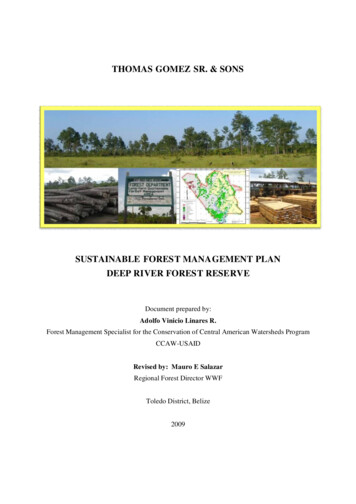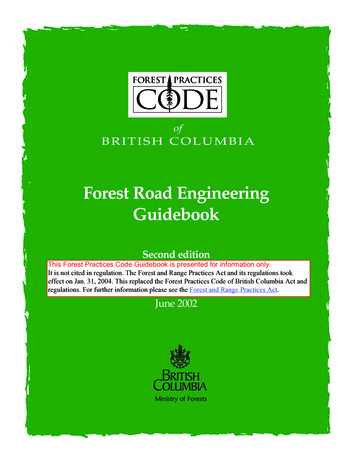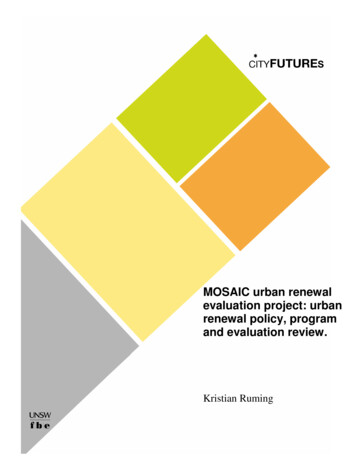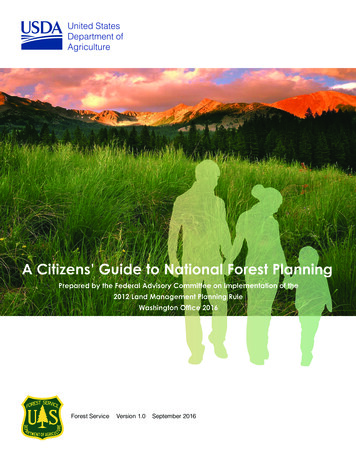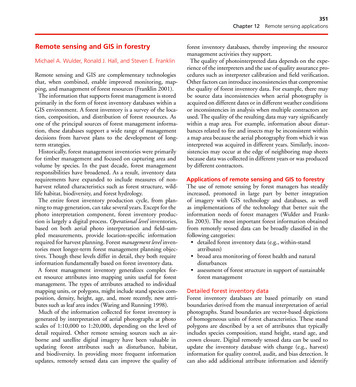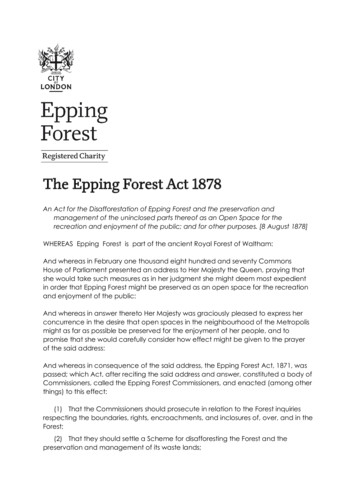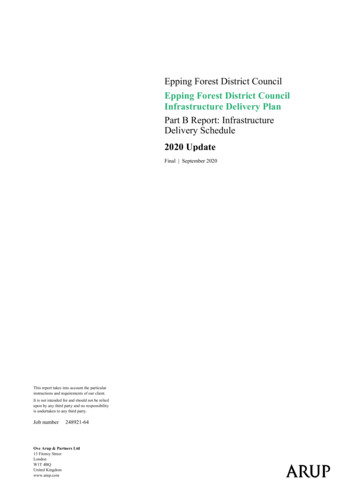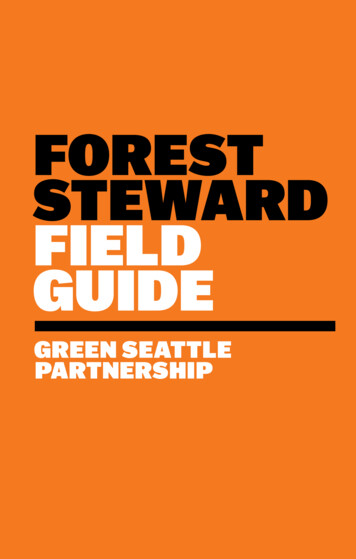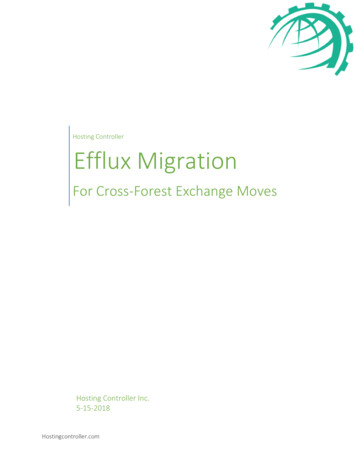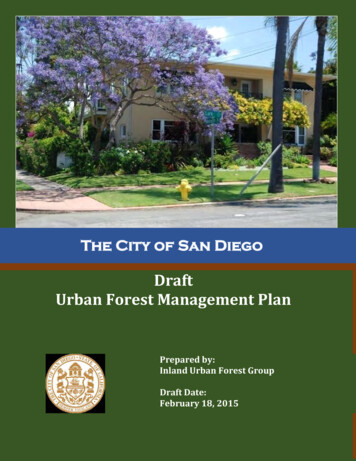
Transcription
The City of San DiegoDraftUrban Forest Management PlanPrepared by:Inland Urban Forest GroupDraft Date:February 18, 2015
Executive SummaryThis Urban Forest Management Plan (Plan) outlines the objectives and actions needed tosustain, protect, and enhance community trees in the City of San Diego. The trees alongstreets, in parks, and in open space areas provide many benefits to the City, its residentsand visitors—they provide shade, save energy, improve air quality and public health,mitigate climate change, reduce stormwater runoff, increase property values, createwildlife habitat, and enhance quality of life.The goals for the urban forest are outlined in the 2008 General Plan. This implementationplan outlines the objectives and actions for achieving those goals, principally to: Establish and maintain optimal levels of tree cover, age and species diversity tomaximize ecosystem benefits provided by urban trees Maintain trees in a healthy condition through good tree care. Incorporate street tree plans and urban forest management in community planupdates. Require planting and maintenance of trees in development permits. Foster public education and community support for urban forestry.This Plan discusses issues and trends that affect San Diego’s urban forest. The mostrecent tree inventory was completed in 2002, and there is a need for an updatedinventory and a tree canopy assessment. Significant investments are needed toimplement a management program to achieve a healthy urban forest, particularly for treeplanting and replacement, watering, pruning and trimming.The City of San Diego’s policies, regulations, and planning documents establish a strongframework for maintaining and enhancing the city’s urban forest. The economicdownturn and recent fiscal challenges have resulted in cuts to tree planting, tree pruningand palm trimming, code compliance, and public education.Recommendations for this plan were based on input from city staff, local urban forestryprofessionals and planners. Community members identified benefits of trees, desires formore trees in their neighborhoods, issues relating to tree care, and their willingness toinvest in trees. Local tree care professionals and planners reviewed and revised theStreet Tree Selection Guide to identify additional species and remove those less suitablefor street tree planting.This plan is meant to be a working document that will be continually implemented andmonitored during the next 20 years. Budget decisions will either limit or enhance thequality and quantity of trees planted and managed, and their resultant contributions toair quality and public health, energy reduction, stormwater retention, climate changeadaptation, and desirability of urban neighborhoods.[Cover photo taken by Marilyn French]City of San Diego Draft Urban Forest Management Plan, February 18, 2015, page i
Table of ContentsExecutive Summary . iIntroduction . 1The Process . 1Overview . 2Environmental and Historical Context. 2Why a Plan Is Needed . 3Benefits Provided by Trees . 3Estimating the Economic Value of San Diego’s Urban Forest . 7Status of San Diego’s Urban Forest . 8Tree Resource Assessment . 8Park and Open Space Trees . 12Tree Planting Goals . 12Tree Resource Management . 15Applicable Regulations . 16Issues and Trends . 20Community Values . 21Goals, Objectives, and Actions . 24Monitoring Plan . 39Financing the Urban Forestry Program . 42Budget History . 42Costs of Tree Planting and Trimming . 44Options for Funding the Urban Forest. 45Appendix A: Proposed Revised Street Tree Selection List . 47Appendix B: Objectives and Actions for FY 2016-2020. 59Appendix C: Projected Costs for Tree Planting and Trimming . 70Provide comments on this draft Urban Forest Management Plan by Friday, March 6, 2015to Melissa Garcia, Senior Planner,. magarcia@sandiego.gov.City of San Diego Draft Urban Forest Management Plan, February 18, 2015, page ii
IntroductionSan Diego is the eighth-largest city in the United States and the second largest inCalifornia, with a population of 1.3 million. 1 San Diego is known for its mildMediterranean climate, tourist destination, border with Mexico, deep harbor, educationalinstitutions, and technology-based industries in the southwest corner of California.San Diego’s tree canopy provides significant contributions to the quality of life forresidents and visitors, because trees make a vital and affordable contribution to the senseof community and create pedestrian-friendly neighborhoods. During the past decade, SanDiego’s tree cover has declined; budgets for tree planting and maintenance have beenreduced; and landscape code violations were given lower priority for enforcement.A diminished urban forestry program reduces public assets, costs taxpayers money, andeliminates grant-funding eligibility. A long-range plan, guided by urban forestryexpertise, is needed to bring together existing policies and guidelines, best urban forestrymanagement practices, and community planning. An effective urban forestry program iscritical to meeting the city’s commitment to sustainability, carbon sequestration,stormwater reduction, water conservation, and climate change, as set out in the 2008General Plan.This Plan provides an overall strategy that will help San Diego maximize its urban forestbenefits for years to come. It covers the city’s street trees, park trees, and trees requiredby development permits on private property. The scope is 20 years with the expectationthat it be reviewed every five years.The ProcessThe City completed the General Plan in 2008, with policies outlining a healthy urbanforest and the development of an urban forestry master plan. In 2013, the City of SanDiego received a grant from the California Department of Forestry and Fire Protection(CAL FIRE) to develop an urban forest management plan. The community outreachprocess began in 2014, to determine and assess community attitudes regarding trees, thebenefits of an urban forest as well as concerns about neighborhood trees.Concurrently, monthly working group meetings were conducted with city staff andcommunity members from April 2014 to February 2015. Interviews were conductedwith individual city staff members during this time. Two public forums or stakeholdermeetings were held on September 22 and 29, 2014, to review the draft goals andobjectives. Stakeholder meetings were held on January 26 and February 2, 2015, toreview the draft plan.12010 census.City of San Diego Draft Urban Forest Management Plan, February 18, 2015, page 1
The goals from the city’s 2008 General Plan were used as the basis for this plan.Objectives were developed to support those goals, and then actions were written toimplement each objective. Public comment on the draft Plan was obtained.OverviewEnvironmental and Historical ContextLocated along the coast of the Pacific Ocean, San Diego's subtropical climate ischaracterized by warm, dry summers and mild winters with most of the annualprecipitation falling between December and March. The city has a mild climate yearround with an average of 201 days above 70 F and low rainfall (9–13 inches annually).San Diego falls into Sunset’s 2 zones 21 and 23 (inland foothills and valleys) and 24(coastal with marine influence).Like most of Southern California, the majority of the City of San Diego's vegetation wasoriginally occupied by chaparral and sage-scrub, plant communities with mostlydrought-resistant shrubs. The steep and varied topography and proximity to the oceancreate a number of different habitats within the city limits. Sycamore, cottonwood, andwillow trees grow in the riparian area along creeks and rivers, with native oaks growingon the slopes.Trees native to many other places can thrive in San Diego’s urban environment. The soilis alkaline and low in organic matter due to the plant types grown here and lack of water.Urban soil is often a mixture of disturbed soils and sometimes construction debris.Frequently, trees have restricted rooting space, often constrained by concrete or asphaltand overhead utility lines. Imported water and recent drought conditions favor selectingtrees with low water requirements.Trees have played a substantial role in San Diego’s history. Olive trees were firstcultivated in California at Mission San Diego de Alcalá in the late 1790s 3. Eucalyptus treeswere planted in the late 1800s with an unrealized promise to produce lumber for railroadties. 4 The citrus trees planted in the early 1900s were gradually replaced by housingdevelopments in the 1950s.Brenzel, Kathleen Norris. The New Sunset Western Garden Book. New York, NY. Time Home EntertainmentInc., 2012. Also described at climate-zone-sandiego-area3 Carter, Nancy C. 2008. San Diego olives: Origins of a California industry. J. San Diego History 54(3):137161. Available at 54-3carter.pdf4 Stanford, Leland. 1970. San Diego’s eucalyptus bubble. J. San Diego History 16(4):. Available calyptus.htm2City of San Diego Draft Urban Forest Management Plan, February 18, 2015, page 2
City Park was established in 1868 and is now known as Balboa Park. The park’s first treeswere planted by Kate Sessions, a renowned horticulturalist, who leased 36 acres for anursery in 1902. In exchange she planted 100 trees a year in the park, and furnished 300more trees annually for planting throughout the city. Today Balboa Park is a significanthorticultural and cultural resource with more than 15,000 trees.From the early 1900s, planners, architects, and landscape architects have beenincorporating trees into their plans for residential developments, business areas, andboulevards. In the late 1990s, the Mayor, City Council and community leaders beganworking together to establish urban forestry initiatives. As a result, the CommunityForest Advisory Board (CFAB) was established in 1999 (formerly known as the TreeAdvisory Board); the City was certified as a Tree City USA in 1999; a Tree ProtectionPolicy was adopted in 2005; and urban forestry guidelines were incorporated into theGeneral Plan in 2008.Why a Plan Is NeededUrban forestry researchers and practitioners draw upon longstanding arboriculturepractices and many scientific and social science disciplines in managing urban trees toprovide environmental, economic, and social benefits. 5 To realize these benefits, acomprehensive vision is needed for the management of the city’s trees, and animplementation schedule followed to secure the resources.An urban forest management plan is a planning process, with a number of steps to gather,analyze, and act on information. The first step is to conduct a tree inventory that consistsof information gathered about specific trees or estimated from aerial images. Thisinformation is then analyzed and evaluated to describe the current state of the urbanforest. The City’s tree inventory is incomplete and outdated, and is a high priority foraccomplishment.Based on the tree inventory, management goals are set for the urban forest resources andprogram, including goals for services provided to city residents, percent of urban treecanopy, mix of species by age and location, regulations governing tree cover and care, andtechnical oversight. The resources and actions to achieve these goals are outlinedgenerally in this Plan, and need to be further detailed as tree inventory information isobtained.Benefits Provided by TreesSan Diegans’ quality of life depends on the urban forest, as trees make a vital andaffordable contribution to the sense of community, pedestrian-friendly neighborhoods,energy savings, and air quality. The urban forestry program is critical to meeting thecity’s commitment to climate change, carbon sequestration, stormwater reduction, and5Glossaries of terms used in urban forestry, tree management, and this Plan are available athttp://www.treepeople.org/glossary and http://selectree.com/information.lasso .City of San Diego Draft Urban Forest Management Plan, February 18, 2015, page 3
water conservation. Trees are one of the few infrastructure investments that grow invalue over time.References in this section were taken from the review of benefits of trees and urbanforests by Alliance for Community Trees, which cited 122 references. 6 Other referencesfor the benefits of trees are the Urban Ecosystems and Social Dynamics research programat the USDA Forest Service Pacific Southwest Station; 7 Urban Forests, EnvironmentalQuality and Human Health research program at the USDA Forest Service NorthernResearch Station; 8 and the Human Dimensions of Urban Forest and Urban Greening at theUniversity of Washington. 9Positively Influence Climate . . . and Ensure San Diego’s SustainabilityTrees absorb carbon dioxide and store carbon in wood, which helps to reducegreenhouse gases. Carbon emissions from vehicles, industries, and power plants are aprimary contributor to increased air temperatures in metropolitan areas, because theyslow the passage of heat through the Earth's atmosphere. Urban trees in the United Statesstore 700 million tons of carbon valued at 14 billion with an annual carbonsequestration rate of 22.8 million tons per year valued at 460 million annually. 10Clean Air . . . and Breathe EasyShade trees reduce pollution and return oxygen to the atmosphere. In addition to carbondioxide, trees’ leaves or needles absorb pollutants, such as ozone, nitrogen dioxide, sulfurdioxide, and some particulate matter. As of 2002, San Diego’s community forest removed4.3 million pounds of pollutants from the air annually, a benefit worth 10.8 million. 11Save Energy . . . and Lower the Cost of Cooling and Heating BuildingsAs natural screens, trees can insulate homes and businesses from extreme temperatures,keep properties cool, and reduce air conditioning utility bills. A 20 percent tree canopyover a house results in annual cooling savings of 8 to 18 percent and annual heatingsavings of 2 to 8 percent. 12 By planting shade trees on sunny exposures, residents andbusinesses can save up to 50 percent on hot-day energy bills. 136Alliance for Community Trees. 2011.Benefits of trees and urban forests: A research list. Unpublishedwhite paper, 19 pp. Available at http://www.actrees.org/files/Research/benefits of trees.pdf . Refer to thisreport for full citations of the source documents.7 Greg McPherson, USDA Forest Service, http://www.fs.fed.us/psw/programs/uesd/8 David Nowak, USDA Forest Service, http://www.nrs.fs.fed.us/units/urban/9 Kathleen Wolf, University of Washington, http://naturewithin.info/10 Alliance For Community Trees 2011, reference 5211 American Forests 200312 Alliance For Community Trees 2011, reference 1313 Alliance For Community Trees 2011, reference 91City of San Diego Draft Urban Forest Management Plan, February 18, 2015, page 4
Reduce Street Maintenance . . . and Save MoneyShaded streets last longer and require far less pavement maintenance, reducing longterm costs. Canopy diminishes pavement fatigue, cracking, rutting, and other damage,reducing repair costs up to 60 percent. 14 A study from University of California at Davisfound that 20 percent shade cover on a street improves pavement condition by 11percent, which is a 60 percent savings for resurfacing over 30 years. 15Raise Property Values . . . and Compound AssetsTrees are sound investments, for businesses and residents alike, and their value increasesas they grow. Sustainable landscapes can increase property values up to 37 percent. 16The value of trees appreciates over time, because the benefits grow as they do. Forbusinesses, trees have added value, including higher revenues. Shoppers seek out leafypromenades that frame storefronts. Research shows that shoppers spend more onproducts in tree-lined business districts—between 9 and 12 percent more. 17, 18Clean Water . . . and Conserve Water and SoilA tree's fibrous roots, extending into the soil, are premier pollution filtration and soilerosion prevention systems. In 2002, more than 39 percent of San Diego was coveredwith impermeable surfaces. 19 In contrast to an impervious hardscape, a healthy urbanforest can reduce annual storm water runoff up to 7 percent. 20 Highly efficient trees alsoutilize or absorb toxic substances such as lead, zinc, copper, and biologicalcontaminants. 21 One study estimated that eliminating the need for additional stormwaterfiltration systems would result in savings exceeding 2 billion. 22Cool Pavement . . . and Diminish Urban Heat IslandsBroad canopy trees lower temperatures by shading buildings, alphalt and concrete;deflecting radiation from the sun, and releasing moisture into the air. The “urban heatisland effect” is the resulting higher temperature of areas dominated by buildings, roads,and sidewalks. Cities are often 5 to 10 F hotter than undeveloped areas, because hotpavement and buildings have replaced cool vegetated land. 23 In addition, hightemperatures increase the volatility of automobile oil and oil within the asphalt itself,releasing the fumes into the atmosphere. Shade trees can reduce asphalt temperatures byas much as 36 F, thus diminishing the fumes and improving air quality. 24Alliance For Community Trees 2011, reference 42Alliance For Community Trees, 2011, reference 9616 Alliance For Community Trees, 2011, reference 1317 Alliance For Community Trees, 2011, reference 4518 Alliance For Community Trees, 2011, reference 4619 American Forests 200320 Alliance For Community Trees, 2011, reference 1021 Alliance For Community Trees, 2011, reference 1922 San Diego Canyon Policy Portfolio, 2006, Preamble, Ecosystem Services Analysis.23 Alliance For Community Trees, 2011, reference 1524 Alliance For Community Trees, 2011, reference 421415City of San Diego Draft Urban Forest Management Plan, February 18, 2015, page 5
Protect Wildlife . . . and Restore EcosystemsPlanting and protecting trees can provide habitat for hundreds of birds and smallanimals. San Diego is often cited as a region with more plant and animal species than anyother in the United States, yet urbanization and the destruction of valuable ecosystemshave led to the decline of many of these species. Only 10 percent of San Diego’s nativecoastal sage scrub and five percent of wetland habitats remain. Adding trees, particularlynative trees, provides valuable habitat for wildlife.Build Safe Communities . . . and Decrease CrimePolice and crime prevention experts agree that trees and landscaping cut the incidence oftheft, vandalism, and violence by enhancing neighborhoods. Thriving trees on wellmaintained streets indicate pride of ownership. Public housing residents with nearbytrees and natural landscapes reported 25 percent fewer acts of domestic aggression andviolence. 25 Apartment buildings with high levels of greenery had 52 percent fewer crimesthan those without any trees. Buildings with medium amounts of greenery had 42percent fewer crimes. 26Calm Traffic . . . and Make Neighborhoods Safer and QuieterPeople drive more slowly and carefully through tree-lined streets, because trees create anillusion of narrower streets. One study found a 46 percent decrease in crash rates acrossurban arterial and highway sites after landscape improvements were installed. 27 Thepresence of trees in a suburban landscape reduced the cruising speed of drivers by anaverage of three miles per hour. Faster drivers and slower drivers both drove atdecreased speeds in the presence of trees. 28Trees reduce noise pollution, buffering against as much as half of our urban noise. Byabsorbing sounds, a belt of trees 100 feet wide and 50 feet tall can reduce highway noiseby 6 to 10 decibels. 29 Buffers composed of trees and shrubs can reduce 50 percent ofnoise. 30Live Well . . . and Reduce StressNeighborhoods with generous canopies of trees are uplifting and good for public health.Greater contact with natural environments correlates with lower levels of stress,improving performance. 31 Studies show that children with attention deficit disorderfunction better after activities in green settings. A green environment impacts workerproductivity; workers without views of nature from their desks claimed 23 percent moreAlliance For Community Trees, 2011, reference 69Alliance For Community Trees, 2011, reference 8227 Alliance For Community Trees, 2011, reference 3828 Alliance For Community Trees, 2011, reference 4029 Alliance For Community Trees, 2011, reverence 9030 Alliance For Community Trees, 2011, reference 3931 Alliance For Community Trees, 2011, reference 312526City of San Diego Draft Urban Forest Management Plan, February 18, 2015, page 6
sick days than workers with views of nature. 32 Residents of areas with the highest levelsof greenery were three times as likely to be physically active and 40 percent less likely tobe overweight than residents living in the least green settings. 33Estimating the Economic Value of San Diego’s Urban ForestThe San Diego County Tree Map 34 has functions to calculate the environmental benefitstrees provide: gallons of stormwater retained, pounds of air pollutants captured,kilowatt-hours of energy conserved, and tons of carbon dioxide removed from theatmosphere. The benefits of the 200,000 trees in the City’s recent tree inventory are: Estimated annual greenhouse gas benefits are 10,800,000 pounds CO2 reduced(4,889 metric tons (MT), rounded to 5,000 MT), for a value of 215,000. 35These trees conserve an estimated 47,000,000 gallons of water per year (savingsof 86,145). 36 Rather than being a net user of water (and thus indirectly energy),trees conserve water by intercepting rainfall, increasing stormwater retention,and requiring only limited water after initial establishment.The estimated annual energy savings are 4,970,000 kWh conserved, for a value of 800,000 (about 4 per tree per year).The trees also capture 32,000 pounds of air pollutants annually, an estimatedannual value of 1,700,000.Alliance For Community Trees, 2011, reference 29Alliance For Community Trees, 2011, reference 2534 San Diego County Tree Map, www.sandiegotreemap.org, Type location as “San Diego” and search. Thisdatabase underestimates the trees in San Diego, as it only includes street trees that were inventoried in thepast ten years and does not include trees in parks, residential or commercial properties35Benefits and economic values computed with iTree software from the USDA Forest Service,www.itreetools.org36 San Diego County Tree Map, www.sandiegotreemap.org3233City of San Diego Draft Urban Forest Management Plan, February 18, 2015, page 7
Status of San Diego’s Urban ForestTree Resource AssessmentCanopy CoverTree canopy is an important measure of the urban forest resource. The urban tree canopyis the layer of leaves, branches, and stems of trees that cover the ground when viewedfrom above. Estimates of San Diego’s tree cover vary based on image type, resolution, andtype of study/author.American Forests 37conducted a study of aerial imagery for San Diego comparing 30meter (m) resolution data from 1986 and 2002. Tree cover was estimated at seven percentwith this data. The land uses were calculated as 110,044 acres of urban land (51%),48,674 acres of grassland (22%), 32,956 acres of shrub land (15%), and 14,738 acres oftree canopy (7%). According to this analysis, the City lost 32% of its grassland, 27% of itstree cover, and 7% of its shrub land from 1985 to 2002, while the city’s developed urbanareas increased by 39% in those years.In a national study by the U.S. Department of Agriculture (USDA) Forest Service, treecanopy and impervious surface cover were estimated from maps at 30m resolution from2001 Landsat satellite imagery and published in 2007 38 in conjunction with 1990 and2000 census and geographic data (1:5,000,000 scale cartographic boundary files) toassess current urban and community forest attributes. This analysis of Landsat imageryshowed that the City of San Diego’s tree cover is about 4.2 percent. 39The city is seeking funding to obtain a current urban tree canopy assessment that willenable the city to have a baseline of the status of the current urban tree canopy and to setfuture tree planting goals. Using high-resolution remotely-sensed light detection and ranging(LiDAR) data recently obtained by the City, urban parcels will be ranked on their suitabilityfor establishing new tree canopy, including plantable space, ownership, topography, soils, andother inputs.Street Tree InventoryThe Streets Division completed the most recent tree inventory in 2002. It includes alltrees in public rights-of-way, but not those in assessment districts. City employees andinterns walked the streets with GPS units, identified and recorded data for existing trees,and identified vacant sites. 40 This data is part of the “Street Tree Inventory” database atAmerican Forests. 2003. Urban ecosystems analysis, San Diego, CA. 20 p. Available athttp://www.ufei.org/files/pubs/sandiegouea.pdf, accessed 2/10/1238 Homer, C.; Dewitz, J.; Fry, J.; Coan, M.; Hossain, N.; Larson, C.; Herold, N.; McKerrow, A.; VanDriel, J.N.;Wickham, J. 2007. Completion of the 2001 national land cover database for the coterminous United States.Photogrammetric Engineering and Remote Sensing. 73(4): 337-341. Cited in Nowak and Greenfield, 2010.39 Nowak and Greenfield, 2010.40 Drew Potocki, Urban Forester, City of San Diego, Transportation and Streets Department, personalcommunication March 201437City of San Diego Draft Urban Forest Management Plan, February 18, 2015, page 8
the City, in the “Trees SD” database at the San Diego Association of Governments, 41 and inthe online San Diego Tree Map. 42 The database includes about 200,000 trees. Thenumber of trees and palms varies greatly by community, Table 1 displays trees bycommunity, sorted in descending order of number of trees per street mile. Values of 0(zero) indicate that data has not been recorded for that area.This database likely underestimates the number of trees in the City since it has only beenupdated where tree care management companies (contractors to the city) have pruned,planted, or otherwise treated a tree, entered information into their data base, andprovided that data to the city. The database generally does not include trees in parks,residential, or commercial properties, although citizens can now add data directly intoSan Diego County Tree Map. 43Data from the Tree Map is summarized in Table 2 by community planning area for thenumber of street trees and palms, with calculations made for the percent of street treesplanted. (The total number of trees and palms is lower than the value in Table 1, likelydue to different queries of the data.)While San Diego’s streets are lined with an estimated 200,000 trees and palms, it isestimated that they could accommodate more than double that amount. Assuming thatfull capacity would be one tree every 50 feet (on both sides of the street), or 200 trees perstreet mile, the tree and palm species were tabulated for each community planning area.Many planting opportunities exist in the city, such as along under-planted arterials; inolder, established neighborhoods where trees may have been lost; in new, treelessneighborhoods;
City of San Diego Draft Urban Forest Management Plan, February 18, 2015, page 3 City Park was established in 1868 and is now known as Balboa Park. The park's first trees were planted by Kate Sessions, a renowned horticulturalist, who leased 36 acres for a nursery in 1902. In exchange she planted 100 trees a year in the park, and furnished 300
